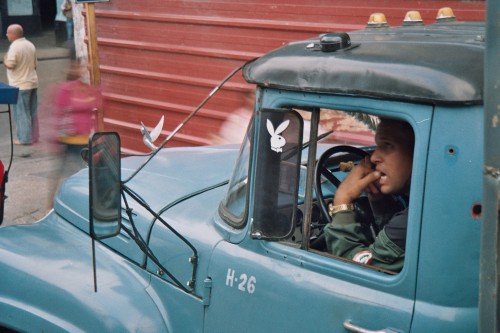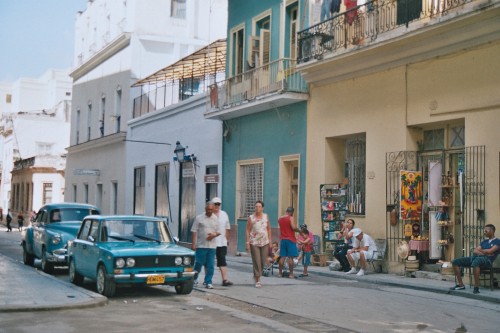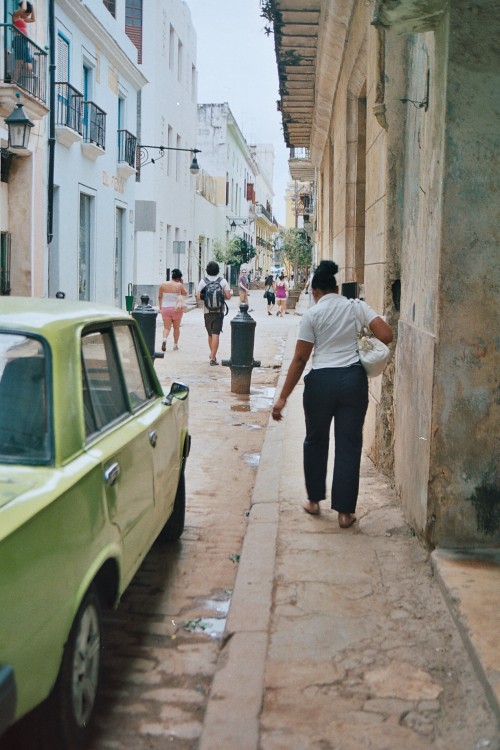Golden Oldies
April 12, 2012 by lastamm
When we exited the Jose Marti airport in Havana, I remember how disappointed I was, seeing our modern-looking bus, surrounded by other post-1950s cars. I was so confused. It was all I had ever heard about Cuba, and the first question I was asked when I returned.
When CNBC talks about Cuba’s cars…
Soviet era Fiats, Ladas, and UAZs and more current Asian and European models fall into the mix, along with beautiful American cars from the 1950s of all sizes and colors.
With the US embargo, American cars post-1959 can’t be seen on the road in Cuba. Unable to get new parts, Cubans became resourceful, using parts from different cars to fix up old American standbys.
The Cuban government views car ownership a privilege rather than a right.
We learned about the license plates and their color coded system, adopted from the Soviet Union.

Government owned cars have blue plates with letters and numbers which indicate when and where the vehicle can be used, and how the driver can use it. Executives at government firms have caramel-colored plates. Military vehicles wear mint-green, only rear plates, and olive-green mean Ministry of the Interior. Foreign diplomats have black plates, and Cuban government ministers, or heads of state organizations have white plates. The last three digits usually convey the rank of the driver, in their profession. Rental cars have maroon plates, while foreign journalists, religious leaders and Cubans working for international firms have neon-orange plates. Red tags are designated for cars which have not yet been officially given a color.
The first letter in the plate signifies which province the car is from, like “H” for Havana.
Cars from Detroit’s epic of industry still roam Cuban streets because Cubans with non-VIP jobs can only buy and sell cars which were manufactured before Fidel Castro came to power in 1959. New cars require state permission; meaning citizens must justify how they can afford a car.
However, things may be changing.
Last year, an official government decree announced Cubans and foreign residents would be able to do what they wanted with their cars “without prior authorization from any entity.” Though limitations still exist, ownership allows for much more freedom than prior legislation. Recently, under Raul’s rule, more private initiatives have been integrated into the command market, in an attempt to better the over all economic well-being of the country. However, wide criticism faces the administration, as so few Cubans have enough money to actually buy the newly-sellable cars.
The most important item on my Cuba bucket list, was to ride in an old American car, and on a whim, I decided to go with a bunch of my fellow travellers to a reggae club, and we found an Oldsmobile. In an effort to save our last CUCs, we pretended not to be the obviously white gringo tourists we were, and spoke Spanish the whole time we were in the taxi. The driver sped along the Malecon, and as we drank our last Rum, we said goodbye to Cuba the right way.
Sources:
http://www.curiousread.com/2010/03/in-cuba-colored-license-plates-tag-all.html
http://www.cnn.com/2011/WORLD/americas/04/21/cuba.classic.cars/index.html
http://www.npr.org/2011/10/31/141858419/in-cuba-a-used-car-is-no-bargain
http://www.reuters.com/article/2011/09/29/uk-cuba-cars-idUSLNE78S01I20110929
One Response to “Golden Oldies”
Leave a Reply
You must be logged in to post a comment.



Kind driving Experience